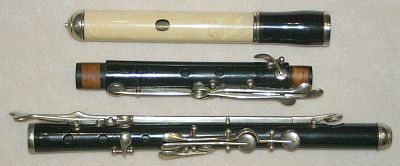
Top: anonymous (mid-19C). Bottom: C. Peloubet (New York, c.1830)
There were very few serious wind instruments made in the United States in the 18th century; instruments were imported from England and Germany. US laws imposing embargos or tariffs on imports from 1807–1814 were in part responsible for the rise of musical instrument manufacturing in the early 19th century. Flutes and clarinets predominated in the output of woodwinds.
Many Amercican flutes from the early and mid-nineteenth centuries look similar to those below. These were inexpensive flutes.

The one-key instrument is a fine example of what it is. It has a strong, bright tone and speaks easily in the very highest notes. But it is totally useless for complex music. In Eb major, for example, the intonation is uncorrectable, especially in the low octave. It seems that when many 19th century makers made one-key flutes, they used the same design as on their multi-keyed flutes, with larger holes than one finds on 18th century flutes. Without additional keys, this design cannot handle flat keys signatures. The instrument would have been used for home or dance music in D or G, or perhaps in amateur bands of some kind.
The four-key instrument is anonymous, but its somewhat chair-leg shape—with no bulges on the tube except for the narrow ivory mounts and narrow wooden ring for the D# key—makes it clear that it is of American manufacture. This is confirmed, as far as I can judge, by its typically American playing characteristics, which cannot easily be put into words, so I will just say it is also bright with easy high notes. In general, early 19C American flutes can have very good third octaves.
As one might guess, English flutes exerted the strongest influence on early 19th century American makers, some of whom had immigrated from England. Later in the century a German influence would appear. There are fewer American-made simple system flutes from late in the 19th century, presumably in large part because of inexpensive German imports.
One very important and innovative American maker was George Catlin, a fifth-generation New Englander. He is a special interest of mine. Click below for a page on Catlin's flutes.

The two flutes below were made in New York, both about 1830. The eight-key flute on the top is by Edward Riley, who emigrated from London to New York about 1805. The four-key flute below is by Firth and Hall. John Firth came to the US from Yorkshire about 1810, apprenticed with Riley, and married one of his daughters. His partner William Hall, who had also worked for Riley, also married one of Riley's daughters.

This flute by Riley is fine example of his work with an ivory head joint and medium-size holes. (American flutes almost never have the really large holes of the English Nicholson-style flutes.) It is similar in shape and manufacture to the eight-key instruments made by the London firm of Rudall & Rose at that time. It is, however, brighter sounding than the Rudall & Rose flutes I have known. Ivory flutes were still common in England, but the combination of an ivory head on a wooden body was not. The combination is seen on American flutes (and would be very popular on German-style flutes in the second half of the century).
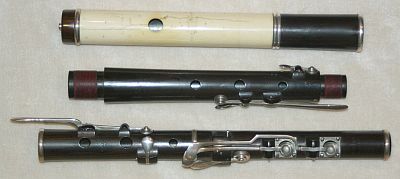
The Firth and Hall flute has somewhat smaller holes, but a strong sound in spite of that. It has a somewhat different, but still very English (with its sharp angles), profile, and has salt-spoon keys.

The flute below is by Firth, Pond & Co. (1847–1863) of New York, a later partnership of Firth. We still have the eight standard keys mounted in wooden blocks, and pewter plugs on the foot keys. It would appear to be an excellent instrument for playing the works of American songwriter Stephen Foster (1826–1863). Foster played the flute, and owned an instrument by Firth, Pond. Much of his music, including the compendium of arrangements The Social Orchestra of 1854, was published by Firth, Pond & Co.


Here are two flutes by German immigrants, both probably from 1860–70, or so.

The appearance of the ten-key Pfaff is distinctive. The three piece construction with a B-foot is German, but much of the look and, for example, the shape of the key touches, is special. The finger holes are relatively large. The sound is bright, and the high notes, to c'''' and beyond, are good. (The original head and barrel were cracked beyond repair; the ones seen above are reconstructions by Michael Hubbert using the original silver tubes and rings. Every spring but one was broken and has been replaced.)
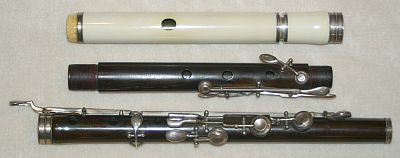
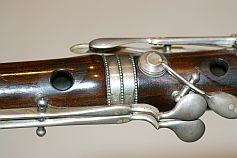
The eight-key Rönnberg has a bit less of what I think of as the American playing characteristics. It is somewhat old-fashioned in having the G# hole on the lower joint (as on early 19C German flutes). The G# hole is much larger than the others and causes some tonal inequality. The arrangement of the keys for low C and C# is unusual: The touch of the low C# key is given to LH4, the form of a key on the flute played by Frish, as reported in the last section of 19C simple system flutes, II. And here the touch of the low C key is to the right of the D# key touch, instead of on the audience side of the D# key.
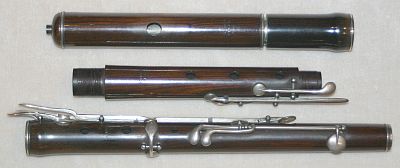
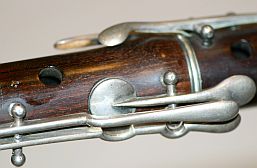
George Cloos came to New York from Germany by 1862. His simple system instruments are quite similar to many German flutes. Late examples I have seen have holes on the large side and a big sound.

Shown above and below is a small "third-flute" by Cloos, so called because it has six-finger note f', a (minor) third above d'. It is unusual in having a full eleven keys and a "B-foot" (sounding d'). Most third-flutes are simple instruments with one, four, or six keys and with low note f', i.e. without an extended foot. The flute has a charming sound, with a bit of piccolo-color.
